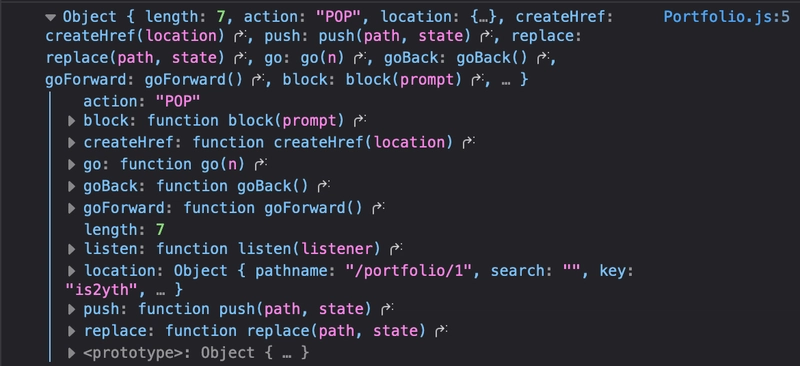react-router:useHistory、useLocation 和 useParams
介绍
相信你已经读过我之前的博客,所以你已经知道这三个路由属性是什么了。如果你还不了解,可以在这里查看我之前的博客。我讨论了如何传递这三个路由属性,并且想向你展示另一种更简单的方法来访问它们,而无需考虑将其作为属性传递。
使用历史
基本上,这个钩子让你可以访问history对象,并且可以使用一些函数来导航你的页面。一切都是为了导航。这就是你的使用方法useHistory。
import { useHistory } from 'react-router-dom';
const Portfolio = (props) => {
const history = useHistory();
console.log(history);
return (
<div>
Portfolio
</div>
);
};
export default Portfolio;
历史里面有什么?
好吧……这里有很多东西。我知道一开始可能会让人困惑。我会解释一下这些属性最常见的用途。
- length(数字):您访问的页面的长度。
- 操作(字符串):(POP,PUSH,REPLACE)
- POP:通过url访问路线,使用history go函数(
history.goBack(),,history.goForward())history.go() - 推:使用
history.push() - 替换:使用
history.replace()
- POP:通过url访问路线,使用history go函数(
- .push(pathname: string, state: any)/(location: object):将路径或位置推送到历史记录堆栈。推送有多种使用方法,我将在下面展示一些示例。
//using pathname
history.push("/blog");
//https://localhost:3000/blogs
//using pathname and state
history.push("/blog", { fromPopup: true });
//https://localhost:3000/blogs
//using location
history.push({
pathname: "/blogs",
search: "?id=5",
hash: "#react",
state: { fromPopup: true }
});
// https://localhost:3000/blogs?id=5#react
我以前从未使用过状态。不过,在阅读了文档之后,它给了我一些启发。例如,如果你想知道用户来自哪里,就可以利用状态。
- .replace(pathname: string, state: any)/(location: object):这基本上与 push 类似,但它会删除现有历史记录并更新为新的历史记录。此后,每当用户在浏览器中点击“返回”时
.replace,它都不会返回到上一个历史记录。 - .goBack():返回上一个历史记录。
- .goForward():前进到上一个历史记录。
- .go(delta: number):移动到不同的索引,并可以指定从该位置起有多少个索引(可以是负数或正数)
我从来没有使用过three.go函数,但我只是想让你知道这个函数在历史上存在过
我还准备了codesandbox来帮助您理解。
使用位置
简而言之,这就像一个始终返回当前 URL 的状态。如果 URL 发生变化, useLocation 也会更新。
里面的位置是什么?
useLocation 不具备类似 useHistory 的任何功能,它只是用于获取有关当前 URL 的信息。
.push我将在示例中使用我们尝试从历史记录中使用的先前链接localhost:3000/blogs?id=5#react。
从该 URL,如果我们尝试调用 useLocation,我们将获得该对象。
只要记住目的useLocation()是从当前路线获取信息,它将返回这些属性。
{
key: 'ac3df4', // not with HashHistory!
pathname: '/somewhere',
search: '?some=search-string',
hash: '#howdy',
state: {
[userDefined]: true
}
}
useParams
这是 React-router 中最容易理解的钩子。每当调用此钩子时,你都会得到一个将所有参数存储为属性的对象。
您只需要这一行代码就可以访问您的参数。
const params = useParams();
你可以在我的 CodeSandBox 中玩一下
结论
我希望这篇文章能帮助你理解 React-router 的三个主要实用钩子。一开始可能会有点困惑,但经过一番尝试之后,一切都变得清晰易懂了。祝你玩得开心!欢迎在评论区留言提问。
文章来源:https://dev.to/raaynaldo/react-router-usehistory-uselocation-and-useparams-10cd 后端开发教程 - Java、Spring Boot 实战 - msg200.com
后端开发教程 - Java、Spring Boot 实战 - msg200.com


